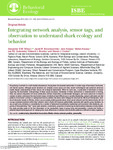Integrating network analysis, sensor tags, and observation to understand shark ecology and behavior
| dc.contributor.author | Wilson, Alexander | |
| dc.contributor.author | Brownscombe, JW | |
| dc.contributor.author | Krause, J | |
| dc.contributor.author | Krause, S | |
| dc.contributor.author | Gutowsky, LFG | |
| dc.contributor.author | Brooks, EJ | |
| dc.contributor.author | Cooke, SJ | |
| dc.date.accessioned | 2018-05-09T10:18:54Z | |
| dc.date.available | 2018-05-09T10:18:54Z | |
| dc.date.issued | 2015 | |
| dc.identifier.issn | 1045-2249 | |
| dc.identifier.issn | 1465-7279 | |
| dc.identifier.uri | http://hdl.handle.net/10026.1/11449 | |
| dc.description.abstract |
Group living in animals is a well-studied phenomenon, having been documented extensively in a wide range of terrestrial, freshwater, and marine species. Although social dynamics are complex across space and time, recent technological and analytical advances enable deeper understanding of their nature and ecological implications. While for some taxa, a great deal of information is known regarding the mechanistic underpinnings of these social processes, knowledge of these mechanisms in elasmobranchs is lacking. Here, we used an integrative and novel combination of direct observation, accelerometer biologgers, and recent advances in network analysis to better understand the mechanistic bases of individual-level differences in sociality (leadership, network attributes) and diel patterns of locomotor activity in a widespread marine predator, the lemon shark (Negaprion brevirostris). We found that dynamic models of interaction based on Markov chains can accurately predict juvenile lemon shark social behavior and that lemon sharks did not occupy consistent positions within their network. Lemon sharks did however preferentially associate with specific group members, by sex as well as by similarity or nonsimilarity for a number of behavioral (nonsimilarity: leadership) and locomotor traits (similarity: proportion of time swimming "fast," mean swim duration; nonsimilarity: proportion of swimming bursts/transitions between activity states). Our study provides some of the first information on the mechanistic bases of group living and personality in sharks and further, a potential experimental approach for studying fine-scale differences in behavior and locomotor patterns in difficult-to-study organisms. | |
| dc.format.extent | 1577-1586 | |
| dc.language | en | |
| dc.language.iso | en | |
| dc.publisher | Oxford University Press (OUP) | |
| dc.subject | accelerometry | |
| dc.subject | intermittent locomotion | |
| dc.subject | Markov chains | |
| dc.subject | network position | |
| dc.subject | personality | |
| dc.title | Integrating network analysis, sensor tags, and observation to understand shark ecology and behavior | |
| dc.type | journal-article | |
| dc.type | Journal Article | |
| plymouth.author-url | https://www.webofscience.com/api/gateway?GWVersion=2&SrcApp=PARTNER_APP&SrcAuth=LinksAMR&KeyUT=WOS:000365704900019&DestLinkType=FullRecord&DestApp=ALL_WOS&UsrCustomerID=11bb513d99f797142bcfeffcc58ea008 | |
| plymouth.issue | 6 | |
| plymouth.volume | 26 | |
| plymouth.publication-status | Published | |
| plymouth.journal | Behavioral Ecology | |
| dc.identifier.doi | 10.1093/beheco/arv115 | |
| plymouth.organisational-group | /Plymouth | |
| plymouth.organisational-group | /Plymouth/Faculty of Science and Engineering | |
| plymouth.organisational-group | /Plymouth/Faculty of Science and Engineering/School of Biological and Marine Sciences | |
| plymouth.organisational-group | /Plymouth/REF 2021 Researchers by UoA | |
| plymouth.organisational-group | /Plymouth/REF 2021 Researchers by UoA/UoA07 Earth Systems and Environmental Sciences | |
| plymouth.organisational-group | /Plymouth/Users by role | |
| plymouth.organisational-group | /Plymouth/Users by role/Academics | |
| dc.identifier.eissn | 1465-7279 | |
| dc.rights.embargoperiod | No embargo | |
| rioxxterms.versionofrecord | 10.1093/beheco/arv115 | |
| rioxxterms.licenseref.uri | http://www.rioxx.net/licenses/all-rights-reserved | |
| rioxxterms.type | Journal Article/Review |


